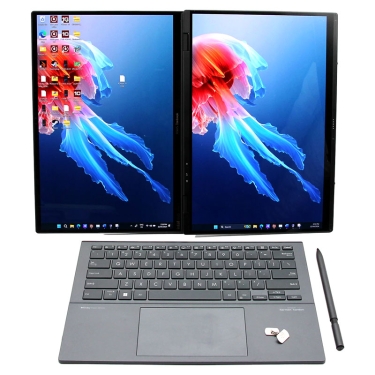Asus Zenbook Duo UX8406 Specs
| Screen | 2 x 14-inch, glossy, 120Hz, 2,880 x 1,800, OLED, HDR displays |
| Processor | 1-5.1GHz Intel Core Ultra 9 185H CPU |
| Memory | 32GB LPDDR5 RAM |
| Graphics | 2.35GHz Intel Arc integrated GPU |
| Hard drive | 1TB |
| Connectivity | Wi-Fi 6E Bluetooth 5.3 1 x USB-A 3.2 Gen 1 2 x Thunderbolt 4 3.5mm audio jack HDMI 2.1 |
| Speakers | 1 (unspecified) |
| Extra Security | Webcam-based Windows Hello |
| Webcam | Full HD |
| Battery | 75Wh |
| Dimensions | 314 x 218 x 15mm |
| Weight | 1.7KG |
| SKU | UX8406MA |
Features, Ergonomics and Design
It takes more than a cursory glance to see that the Asus Zenbook Duo UX8406 isn’t just a regular laptop. The dark “Inkwell Gray” chassis is cool and classy and should fit into any work or play-based environment. The subtle, glossy geometric lines on the lid are understated and sophisticated. Opening it up reveals an OLED screen and a regular-looking keyboard that’s got white LED backlighting which is adjustable to three levels. It looks and feels like a regular laptop.

However, the whole keyboard lifts off to reveal a second OLED screen and this can be used in multiple formats. In the first ‘Dual Screen Mode’ the physical keyboard is removed entirely and you can use the a virtual version (replete with virtual trackpad) on the second display. It’s impressively responsive albeit somewhat firm on your fingers.

In the second ‘Dual Screen Mode’ you can make use of a discreet, high-quality kickstand to prop it up for use as a dual-screen ‘laptop’ with the physical keyboard beneath it:

In ‘Desktop Mode’ you can set-up the dual screens in portrait mode and use them like a two-screen desktop PC with the physical keyboard.

In ‘Sharing Mode’ you can fold the two screens down flat(ish) and show someone opposite what you’re working on. You can also potentially use it as a large tablet although the hinge, while strong, doesn’t quite work as a well as a regular tablet.
The screens themselves are very impressive. They both have high, 2,880 x 1,800 resolutions and support Windows HDR very well (to the point where we left it turned on all the time). The Windows Desktop is sharp and clear, colours are vibrant, blacks are true and there’s more detail visible in highlights and shadowy areas than most rivals.
Lights that shine out of dark areas on the bright (500-nit peak) screen really pop to make you feel like they’re genuinely shining out of the screen. It’s also Pantone-validated for colour accuracy and supports 100 per cent of the tricky DCI-P3 colour space which designers will like.
On top of all that, it fends-off 70 per cent of harmful blue light to protect against eye strain plus, it comes with Asus’ stylus.
The only downside is that the glossy finish turns into a black mirror when viewing dark content.
The screen(s) can also flit between 60Hz and 120Hz depending on whether you want to save power or rig for fast-moving objects. It’s not the fastest screen we’ve seen – there’s some noticeable blur when some objects move quickly, but only players of fast-moving games would object and, it’s always worth stressing, this isn’t a gaming laptop.
The keyboard sits atop the second screen very securely to the point where you’d be forgiven for thinking it permanently resides there. However, it’s easy to lift off and reattach thanks to integrated magnets. It automatically charges when attached to the Duo but it can be charged separately via mini-USB when separated from it, too.
The keyboard itself is solid and is just as usable as a regular model – albeit ever-so-slightly stiffer. The trackpad feels like a regular trackpad, too. It’s very smooth, accurate and the soft button actuations are accurate and quiet.

Inside the Zenbook Duo is a “Built-in speaker.” No specs are given, which didn’t fill us with confidence, but we were particularly impressed by the all-round fidelity, loudness and punchy bass that “it” delivered.
Meanwhile, the Full HD webcam does an excellent job of capturing a clear, relatively noise-free image in low light while the microphone array can be configured in the MyAsus app to capture excellent, noise-free audio in a variety of settings including individual presenter and 360-degree, multi-person environments. The 14th-Gen Intel (Meteor Lake) processor’s Neural Processing Unit helps blur the background sharper and more-efficiently than normal meaning it’s excellent for web-conferencing.
All in all, Asus’ new Zenbook Duo literally has the best features and ergonomics that we’ve ever tested. It’s very impressive whether you want a regular laptop or a configurable, mobile, Desktop PC.
Connectivity
Despite its diminutive dimensions, the 2024 Asus Zenbook Duo (UX8406) sports the important ports…


Inside the Duo is Wi-Fi 6E and Bluetooth 5.3. I’d prefer to see Wi-Fi 7 in a 14th-Gen laptop, but that’s still a good connectivity complement for such a thin laptop.
Features, Ergonomics and Design Score: 5 / 5
Performance
Inside the 2024 Zenbook Duo is a 1 – 5.1GHz Intel Core Ultra 9 185H processor which has six Performance cores, eight Efficiency cores and two Low-Power Efficient cores which operate across 22 threads. There’s also a 1.4GHz NPU and integrated 2.35GHz Intel Arc graphics.
This is all flanked by 32GB of fast, low-powered LPDDR5 RAM and a 1TB NVMe drive.
In the general-computing PCMark 10 benchmark which uses all of a computer’s components, the Zenbook Duo scored 7,160 which is impressive for such a thin device. (Score: 3.3 / 5)
In the Cinebench CPU-based rendering benchmarks, the Duo scored 2,631 in the quick R15 drag race and 13,506 in the longer R23 test. These are just about average in the big wide world of laptops which is, again, impressive for this type of ultraportable. (Score: 2.4 / 5)

The integrated Intel Arc GPU couldn’t run the tricky 3DMark ray-tracing-based gaming tests, Port Royal and Speed Way.
However, in the AAA-game-title-mimicking Time Spy and Fire Strike Extreme benchmarks, the Duo scored 3,936 (average 21.8fps) in the former and 4,266 (average 18.8fps) in the latter. While these aren’t high scores, they’re essentially double what we saw with previous generations of integrated Intel Xe GPUs and at least offer a glimmer of hope that mainstream titles can be played on the Zenbook Duo if you lower the resolution and detail settings (considerably).
In the much-easier 3DMark Night Raid test, it scored 29,765 – an average framerate of 189.8 which is more than enough to play casual and competitive games.
Ultimately, Asus’ Zenbook Duo is no gaming laptop, but it’s not totally inept in this field and can sate undemanding casual gamers.
3D Performance Score: 1.6 / 5
Cooling
Under load, the Zenbook Duo can get hot to the point where you wouldn’t want it on your lap and the fans can turn into a not-silent, low, robust whoosh. In whisper mode the fan is still slightly audible but only in a very quiet environment.
Portability and Battery Life
The Zenbook Duo isn’t light at 1.7KG but it’s still relatively small because of its 15mm thickness. Furthermore, if you consider it to be a 28-inch laptop, it’s far from heavy.
It’s very solidly built and the screens flex little when a twisting force is applied. They also use Corning Gorilla glass for strength and the whole laptop is military-grade (MIL-STD 810H) certified so it should survive life on the road despite all that glass.
The power supply is a phone-like charger that only weighs 183g, reducing the overall weight. It also offers fast charging.

The 75Wh battery helped it run our PCMark 10 Modern Office test for an impressive 10 hours flat (when in laptop configuration). Portability and Battery Life Score: 3.2 / 5
Price and Value
Our review unit (code: UX8406MA) and is available for $3,599 but, if you’re quick, you can find it for sale at $200 off. This appears to be the only SKU available in Australia. As such, Asus’ Zenbook Duo is not cheap but it still represents decent value.
Price: 2.1 / 5
Value: 3.5 / 5
Overall
The Asus Zenbook Duo isn’t for everyone but it’s still an excellent laptop with more bells and whistles than anything else I’ve tested. It’s incredibly versatile despite the fact it’s not great for games and there are even more ultraportable alternatives.
Most importantly, it doesn’t feel like an experimental science project that early incarnations of this type of laptop put us in mind of. As such, it should attract a somewhat larger audience which is good because we’re happy to recommended it to them.
Overall: 4.1 / 5












































